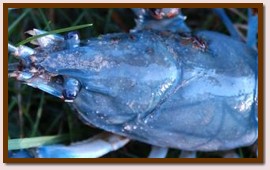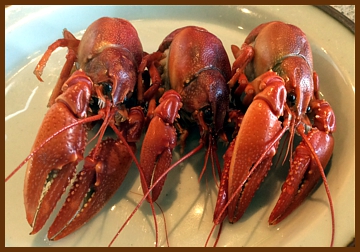
Biology of the Northern Crayfish
By Doug Collicutt |
(Click thumbnail images for larger photos.) |
Description
Crayfish, of which our own Northern Crayfish (Orconectes virilis) is one of about 500 species worldwide, are crustaceans related to copepods, barnacles, crabs, shrimps, lobsters, etc. (Class: Crustacea, Order: Decapoda, Family: Cambaridae, Genus: Orconectes, Species: virilis) The Northern Crayfish grows to a length of about 10-12 cm, not including the 2 pairs of long antennae or the large chelipeds (pron: "keel-i-peds"), the large claw or pincer bearing legs, that extend forward. The chelipeds often have a bluish tint, particularly in the males which have larger chelipeds and larger pincers than females.
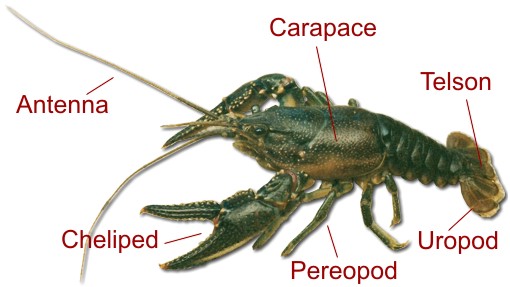
The head and thorax
are covered by a shell-like carapace, usually brownish to rusty red
in colour. There are four pairs of jointed walking legs called pereopods (pron: "pair_ee_oh_pods") also
attached to the thorax. The chelipeds are actually modified  pereopods.
The jointed abdomen, which can be folded under the thorax, has 5 pairs
of small limbs called pleopods (pron: "plee_oh_pods"), or swimmerets. The first two pleopods of males are modified to aid in sperm transfer. In female crayfish the first two pleopods look the same as all the rest. The pleopods beat to maintain a current of water over the feather-like
gills which are located along the sides of the thorax beneath the carapace.
At the end of the abdomen is the telson, which together with the paddle-shaped
uropods forms a flipper-like tail. A crayfish normally walks forward
on its pereopods, but when frightened it flips its tail rapidly and
repeatedly under its thorax and scoots away backwards.
pereopods.
The jointed abdomen, which can be folded under the thorax, has 5 pairs
of small limbs called pleopods (pron: "plee_oh_pods"), or swimmerets. The first two pleopods of males are modified to aid in sperm transfer. In female crayfish the first two pleopods look the same as all the rest. The pleopods beat to maintain a current of water over the feather-like
gills which are located along the sides of the thorax beneath the carapace.
At the end of the abdomen is the telson, which together with the paddle-shaped
uropods forms a flipper-like tail. A crayfish normally walks forward
on its pereopods, but when frightened it flips its tail rapidly and
repeatedly under its thorax and scoots away backwards.
More than 1 crayfish? I guess the plural
of crayfish is crayfish, and as for fish, when you talk about
more than one species it would be crayfishes. |
Distribution
Here's a map of our best guess of the range of the Northern Crayfish in central North America (after Hamr 1998), not including recent introductions. They certainly occur throughout southern Manitoba, but how far north they range isn't known. (Anybody up north know? Drop us a line: Email NatureNorth.com.)
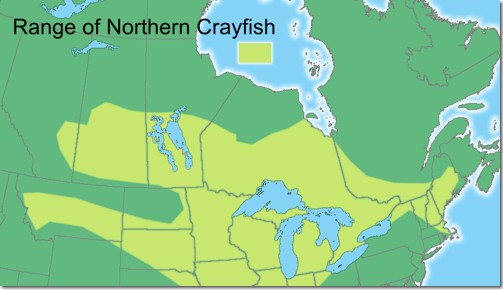
Other Crayfish in Manitoba
There are two other species of crayfish in Manitoba: the Calico Crayfish (Orconectes immunis), also called the Papershell Crayfish, and the Rusty Crayfish (Orconectes rusticus). The Calico Crayfish is native to southern Manitoba, though its range is poorly documented. This species constructs mud chimneys above its burrows in ditches and along waterways making its presence fairly obvious. The crayfish themselves are rarely seen.
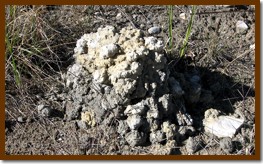 The Rusty Crayfish is an invasive species which has only been confirmed recently to occur in Manitoba in the southeast (2008, Falcon Lake, Whiteshell Provincial Park). The Rusty Crayfish is native to North America, but has been introduced into different water sheds and is spreading rapidly, usually to the detriment of other local crayfishes. Manitoba is trying to limit the spread of Rusty Crayfish to protect the Northern Crayfish and the integrity of our aquatic ecosystems. Interestingly, the Northern Crayfish has been introduced to other North American watersheds and is considered an alien invasive outside its native range, too.
The Rusty Crayfish is an invasive species which has only been confirmed recently to occur in Manitoba in the southeast (2008, Falcon Lake, Whiteshell Provincial Park). The Rusty Crayfish is native to North America, but has been introduced into different water sheds and is spreading rapidly, usually to the detriment of other local crayfishes. Manitoba is trying to limit the spread of Rusty Crayfish to protect the Northern Crayfish and the integrity of our aquatic ecosystems. Interestingly, the Northern Crayfish has been introduced to other North American watersheds and is considered an alien invasive outside its native range, too.
Manitoba Conservation has outlawed the possession of all crayfish, for all purposes, in a sort of (in my opinion) over-the-top response to the Rusty Crayfish situation. Read their position: Manitoba Conservation Rusty Crayfish page.
Habitat
Where do they live? Northern Crayfish probably inhabit all aquatic environments in Manitoba, except marine. They can be found in lakes, rivers, streams, marshes and ponds. Wherever there is a permanent body of water that is deep enough not to freeze solid or experience winter die-off from oxygen depletion, you may find crayfish. The one habitat requirement that the northern crayfish seems to have is the need for shelter in the form of rocks, logs or thick vegetation in which to hide from predators during the day time.
|
Food
Northern Crayfish probably eat all kinds of things. All the literature suggests crayfish eat some aquatic plants as well as invertebrates, such as snails and insects, and tadpoles and small fish. They are probably best described as "opportunistic omnivores", they eat whatever they can get! While they can catch some quick moving prey like tadpoles or fish, they probably get a lot of their food by scavenging dead animals.
Crayfish As Food
What eats crayfish?
Fish are probably the main consumers of crayfish. What fisherman (or
am I supposed to say fisher person now?) doesn't have a rubber crayfish
lure in his (or her) tackle box? Turtles, raccoons, mink, herons,
cranes and lots of other critters will chow down on crayfish when they
can catch them. Crayfish are an important part of the aquatic food chain.
They are also an important part of the human food chain! Well, not so
much in these parts, (Though you'd eat a lobster, right?) but in many
parts of the world crayfish are a delicacy. Remember how Jed, Ellie-May,
Grannie and especially Jethro would smack their 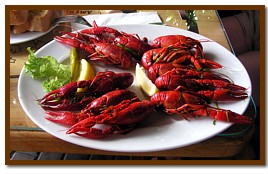 lips at the thought
of a big pot of crawdad gumbo? (Crawdad or crawfish are other names
for crayfish.)
lips at the thought
of a big pot of crawdad gumbo? (Crawdad or crawfish are other names
for crayfish.)
Crayfish are a big-time food item in the United States and, increasingly, in Europe. Close to 45 million kilograms (100 million pounds) of crayfish are harvested annually in the U.S., with most of this coming from aquaculture operations in Louisiana. Crawfish, as they are known there, are important ingredients in Cajun cooking. Crayfish production in Louisiana is the second largest aquacultural industry in the United States.
Reproduction
 Crayfish can mate
in autumn or in spring. However, the eggs are not fertilized and laid
until the spring. The females can store the sperm from a fall mating.
And they protect their eggs by carrying them around under their tales.
The eggs are stuck to the swimmerets in a large ball resembling a raspberry.
In fact, the females are said to be "in berry" while they are carrying
their egg masses. The eggs are laid from late May to early June and
hatch by July. The young hatchlings look just like miniature adults,
and can probably grow to be about 2-3 cm long by the fall.
Crayfish can mate
in autumn or in spring. However, the eggs are not fertilized and laid
until the spring. The females can store the sperm from a fall mating.
And they protect their eggs by carrying them around under their tales.
The eggs are stuck to the swimmerets in a large ball resembling a raspberry.
In fact, the females are said to be "in berry" while they are carrying
their egg masses. The eggs are laid from late May to early June and
hatch by July. The young hatchlings look just like miniature adults,
and can probably grow to be about 2-3 cm long by the fall.
Crayfish don't live very long. The males usually die after mating when they are about 2 years old. The females die after their young hatch, also at about 2 years of age. Crayfish occasionally live longer, but it's thought that none survive beyond their 4th spring.
Habits
Crayfish are most active at night. They leave the protection of the rocks or other cover to forage in the dark, no doubt aided by their long, sensitive antennae. They can even crawl up onto land next to water to go from pool to pool in search of food or to forage along the shore. The location of their gills under the carapace means that they stay moist for some time even when the crayfish is out of the water. This and the crayfish's ability to tolerate low oxygen levels allows them to venture from the water for short periods. If encountered on land by a predator, or a pesky photographer, they adopt a defensive stance with claws at the ready.
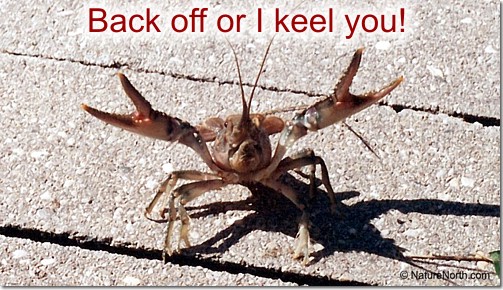
Regular crayfish activity is interrupted periodically for moulting. Like all arthropods (animals with a hard exoskeleton and jointed legs: crustaceans, insects, arachnids, etc.) they must shed their hard shell-like skin in order to grow. For several days after moulting, crayfish stay in seclusion until their new skin hardens enough to protect them from predators.
What do crayfish do in winter? It's thought that they become much less active, but they do not go dormant or hibernate. Adult crayfish move to deeper water for the winter to avoid possible freeze-outs.
Thanks for learning about the Northern Crayfish!
Here's a little extra: Crayfish in the Class Room
Acknowledgments
Some of the information in this article was drawn from the following sources or individuals:
The Handbook of Crayfish of Ontario. By D.W. Crocker & D.W. Barr. 1968. Published by University of Toronto Press
Conservation Status of Canadian Freshwater Crayfishes. By Dr. Premek Hamr for World Wildlife Fund Canada and the Canadian Nature Federation. March 1998, 87 pages.
Fred Schueler, Eastern Ontario Biodiversity Museum Grenville Co, Ontario, Canada (RR#2 Oxford Station, K0G 1T0)
Some Online Resources:
Brigham Young University - Crayfish Lab (A great site for learning about crayfish in general! Includes a great key to species.)
Global Invasive Species Database - Orconectes virilis
Rusty Crayfish: A Nasty Invader
Return to The Northern Crayfish | Fall Issue | NatureNorth Front Page


